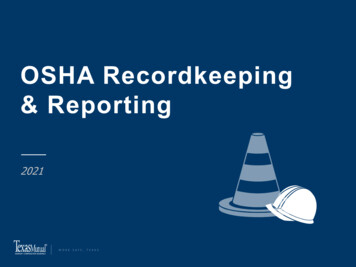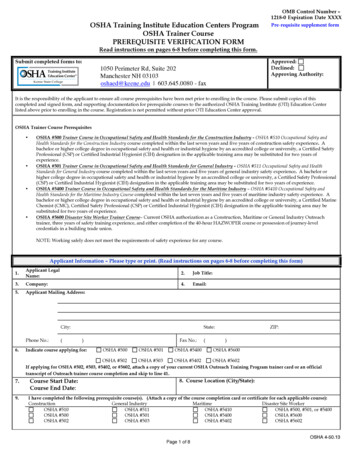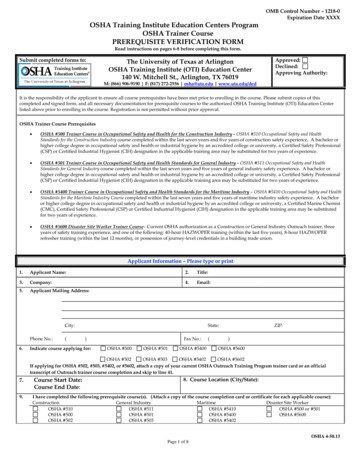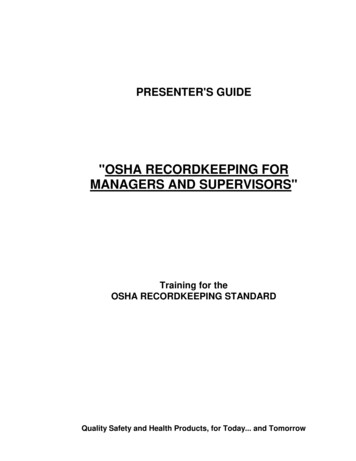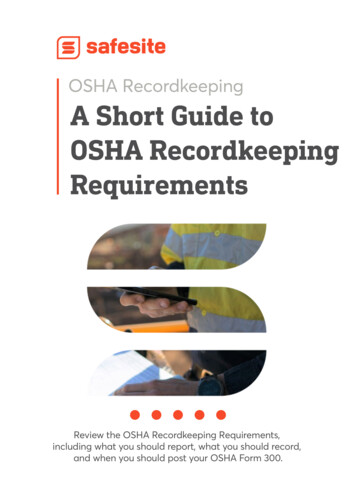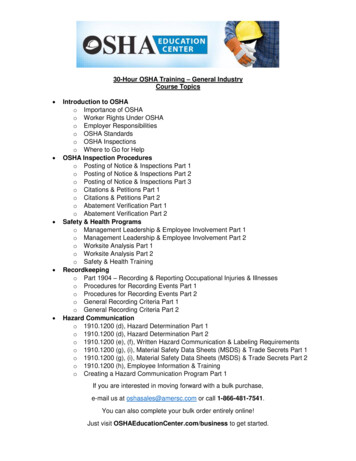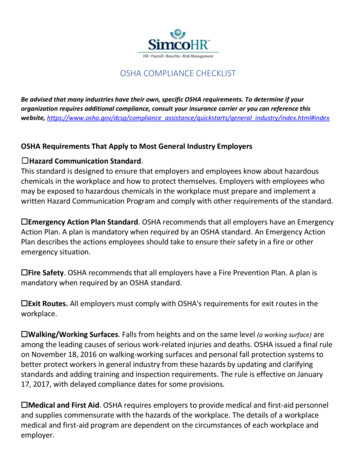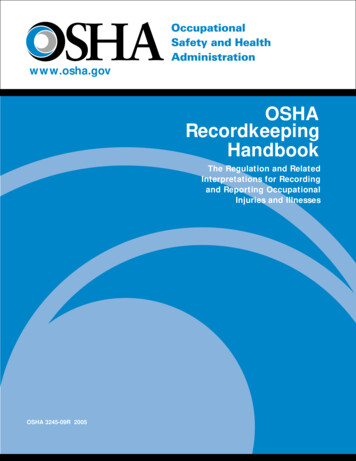
Transcription
www.osha.govOSHARecordkeepingHandbookThe Regulation and RelatedInterpretations for Recordingand Reporting OccupationalInjuries and IllnessesOSHA 3245-09R 2005
Employers are responsible for providing a safe andhealthful workplace for their employees. OSHA’srole is to assure the safety and health of America’sworkers by setting and enforcing standards; providing training, outreach and education; establishingpartnerships; and encouraging continual improvement in workplace safety and health. For moreinformation, visit www.osha.gov.This handbook provides a general overview of aparticular topic related to OSHA regulation. It doesnot alter or determine compliance responsibilitiesin OSHA standards or the Occupational Safety andHealth Act of 1970. Because interpretations andenforcement policy may change over time, youshould consult current OSHA administrative interpretations and decisions by the OccupationalSafety and Health Review Commission and theCourts for additional guidance on OSHA compliance requirements.This publication is in the public domain and maybe reproduced, fully or partially, without permission. Source credit is requested but not required.This information is available to sensory impairedindividuals upon request. Voice phone: (202) 6931999; teletypewriter (TTY) number: (877) 889-5627.
OSHARecordkeeping HandbookThe Regulation and Related Interpretations for Recordingand Reporting Occupational Injuries and IllnessesOccupational Safety and Health AdministrationU.S. Department of LaborDirectorate of Evaluation and AnalysisOffice of Statistical AnalysisDivision of RecordkeepingOSHA 3245-09R2005
IntroductionThis OSHA Web-based Recordkeeping Handbookis a compendium of existing agency-approvedrecordkeeping materials, including the regulatorytext from the 2001 final rule on Occupational Injuryand Illness Recording and Reporting Requirements(“the Recordkeeping rule”) and relevant explanatory excerpts from the preamble to the rule; chapter 5 of the agency's Recordkeeping Policies andProcedures Manual; Frequently Asked Questions(FAQs); and OSHA letters of interpretation. ThisWeb-based handbook is intended to be a resourcefor businesses of all sizes, as well as OSHA's compliance safety and health officers, complianceassistance specialists, and OSHA State-plans. Theinformation in the handbook is accessible byOSHAmeans of a user-friendly search engine that relieson simple point-and-click technology. The handbook is designed to answer recordkeeping questions raised by employers, employees, and members of the OSHA family who are familiar with thebasic requirements of the rule but wish to obtainadditional information on specific recordkeepingissues. Users will also find the handbook usefulas a research and training tool. The handbook canbe accessed through the link below, which directsusers to the file. Because the handbook is Webbased, it will be possible to update letters of interpretation and add FAQs to the file quickly as newquestions about the rule are raised.RECORDKEEPINGHANDBOOKiii
PrefaceThe Occupational Safety and Health Act of 1970 (OSHAct) requires covered employers to prepare andmaintain records of occupational injuries and illnesses. The Occupational Safety and Health Administration (OSHA) in the U.S. Department of Labor is responsible for administering the recordkeeping system established by the Act. The OSH Act and recordkeeping regulations in 29 CFR 1904 and 1952 providespecific recording and reporting requirements whichcomprise the framework for the nationwide occupational safety and health recording system.Under this system, it is essential that data recordedby employers be uniform and accurate to assure theconsistency and validity of the statistical data whichis used by OSHA for many purposes, includinginspection targeting, performance measurementunder the Government Performance and Results Act(GPRA), standards development, resource allocation,Voluntary Protection Program (VPP) eligibility, and"low-hazard" industry exemptions. The data also aidemployers, employees and compliance officers inanalyzing the safety and health environment at theemployer’s establishment and is the source ofinformation for the OSHA Data Initiative (ODI) andthe Bureau of Labor Statistics’ (BLS) Annual Survey.In January 2001, OSHA issued a final rule revisingthe § 1904 and § 1952 Occupational Injury and IllnessRecording and Reporting Requirements (Recordkeeping) regulations, the first revision since 1978.The goals of the revision were to simplify the system, clarify ongoing concepts, produce more usefulinformation and better utilize modern technology.The new regulation took effect on January 1, 2002.As part of OSHA’s extended outreach efforts, theagency also produced a Recordkeeping Policies andProcedures Manual (CPL 2-0.135, December 30, 2004),which contained, along with other related information, a variety of Frequently Asked Questions. Inaddition, in 2002, a detailed Injury and IllnessRecordkeeping website was established containinglinks to helpful resources related to Recordkeeping,including training presentations, applicable FederalivOSHARegister notices, and OSHA’s recordkeeping-relatedLetters of Interpretation. (See www.osha.gov/recordkeeping/index.html).This publication brings together relevant informationfrom the Recordkeeping rule, the policies and procedures manual and the website. It is organized by regulatory section and contains the specific final regulatory language, selected excerpts from the relevantOSHA decision analysis contained in the preamble tothe final rule, along with recordkeeping-relatedFrequently Asked Questions and OSHA’s enforcement guidance presented in the agency’s Letters ofInterpretation. The user will find this informationuseful in understanding the Recordkeeping requirements and will be able to easily locate a variety ofspecific and necessary information pertaining toeach section of the rule.The information included here deals only with therequirements of the Occupational Safety and HealthAct of 1970 and Parts 1904 and 1952 of Title 29, Codeof Federal Regulations, for recording and reportingoccupational injuries and illnesses. Some employersmay be subject to additional recordkeeping andreporting requirements not covered in this document. Many specific OSHA standards and regulations have additional requirements for the maintenance and retention of records for medical surveillance, exposure monitoring, inspections, and otheractivities and incidents relevant to occupational safety and health, and for the reporting of certain information to employees and to OSHA. For informationon these requirements, which are not covered in thispublication, employers should refer directly to theOSHA standards or regulations, consult OSHA’s website for additional information (www.osha.gov), orcontact their OSHA regional office or participatingState agency.For recordkeeping and reporting questions not covered in this publication, employers may contact theirOSHA regional office or the participating Stateagency serving their jurisdiction.RECORDKEEPINGHANDBOOK
ContentsRecordkeeping HandbookRoadmapviSection 1904.0Purpose1REGULATIONPREAMBLE DISCUSSIONFREQUENTLY ASKED QUESTIONSLETTERS OF INTERPRETATION1122Section 1904.1Partial exemption for employerswith 10 or fewer employees3REGULATIONPREAMBLE DISCUSSIONFREQUENTLY ASKED QUESTIONSLETTERS OF INTERPRETATION3344Section 1904.2Partial exemption for establishments in certain industriesREGULATIONPREAMBLE DISCUSSIONFREQUENTLY ASKED QUESTIONSLETTERS OF INTERPRETATIONREGULATIONPREAMBLE DISCUSSIONFREQUENTLY ASKED QUESTIONSLETTERS OF INTERPRETATION1010101010Section 1904.4Recording criteria11REGULATIONPREAMBLE DISCUSSIONFREQUENTLY ASKED QUESTIONSLETTERS OF INTERPRETATION11121212Section 1904.5Determination ofwork-relatedness13REGULATIONPREAMBLE DISCUSSIONFREQUENTLY ASKED QUESTIONSLETTERS OF INTERPRETATION13152225OSHAREGULATIONPREAMBLE DISCUSSIONFREQUENTLY ASKED QUESTIONSLETTERS OF INTERPRETATIONSection 1904.7General recording criteriaREGULATIONPREAMBLE DISCUSSIONFREQUENTLY ASKED QUESTIONSLETTERS OF INTERPRETATION37373741424747517878Section 1904.8Recording criteria forneedlestick and sharps injuries 75REGULATIONPREAMBLE DISCUSSIONFREQUENTLY ASKED QUESTIONSLETTERS OF INTERPRETATION7575787855699Section 1904.3Keeping records for morethan one agencySection 1904.6Determination of new casesSection 1904.9Recording criteria for casesinvolving medical removalunder OSHA standardsREGULATIONPREAMBLE DISCUSSIONFREQUENTLY ASKED QUESTIONSLETTERS OF INTERPRETATIONSection 1904.10Recording criteria for casesinvolving occupationalhearing lossREGULATIONPREAMBLE DISCUSSIONFREQUENTLY ASKED QUESTIONSLETTERS OF INTERPRETATIONSection 1904.11Recording criteria for workrelated tuberculosis casesREGULATIONPREAMBLE DISCUSSIONFREQUENTLY ASKED QUESTIONSLETTERS OF 292929696969898v
Deletion 1904.12Recording criteria for casesinvolving work-relatedmusculoskeletal disorders99Sections 1904.12 – 1904.28(Reserved)100Section 1904.29Forms100REGULATIONPREAMBLE DISCUSSIONFREQUENTLY ASKED QUESTIONSLETTERS OF INTERPRETATION100101109110Section 1904.30Multiple businessestablishments113REGULATIONPREAMBLE DISCUSSIONFREQUENTLY ASKED QUESTIONSLETTERS OF INTERPRETATION113113115115Section 1904.31Covered employees116REGULATIONPREAMBLE DISCUSSIONFREQUENTLY ASKED QUESTIONSLETTERS OF INTERPRETATION116116120120Section 1904.32Annual summary127REGULATIONPREAMBLE DISCUSSIONFREQUENTLY ASKED QUESTIONSLETTERS OF INTERPRETATION127127131132Section 1904.33Retention and updatingREGULATIONPREAMBLE DISCUSSIONFREQUENTLY ASKED QUESTIONSLETTERS OF INTERPRETATIONviSection 1904.34Change in business ownership 136134134134135135OSHAREGULATIONPREAMBLE DISCUSSIONFREQUENTLY ASKED QUESTIONSLETTERS OF INTERPRETATIONSection 1904.35Employee involvementREGULATIONPREAMBLE DISCUSSIONFREQUENTLY ASKED QUESTIONSLETTERS OF INTERPRETATIONSection 1904.36Prohibition againstdiscriminationREGULATIONPREAMBLE DISCUSSIONFREQUENTLY ASKED QUESTIONSLETTERS OF INTERPRETATIONSection 1904.37State recordkeepingregulationsREGULATIONPREAMBLE DISCUSSIONFREQUENTLY ASKED QUESTIONSLETTERS OF INTERPRETATIONSection 1904.38Variances from therecordkeeping ruleREGULATIONPREAMBLE DISCUSSIONFREQUENTLY ASKED QUESTIONSLETTERS OF INTERPRETATIONSection 1904.39Reporting fatalities andmultiple hospitalizationincidents to OSHAREGULATIONPREAMBLE DISCUSSIONFREQUENTLY ASKED QUESTIONSLETTERS OF 52153153154154155157157
Section 1904.40Providing records togovernment representativesREGULATIONPREAMBLE DISCUSSIONFREQUENTLY ASKED QUESTIONSLETTERS OF INTERPRETATIONSection 1904.46Definitions158158158160160Section 1952.4Injury and illness recordingand reporting requirementsSection 1904.41Annual OSHA injury andillness survey of ten ormore employers161REGULATIONPREAMBLE DISCUSSIONFREQUENTLY ASKED QUESTIONSLETTERS OF INTERPRETATION161161162162Section 1904.42Requests from the Bureau ofLabor Statistics for dataREGULATIONPREAMBLE DISCUSSIONFREQUENTLY ASKED QUESTIONSLETTERS OF INTERPRETATIONREGULATIONPREAMBLE DISCUSSIONFREQUENTLY ASKED QUESTIONSLETTERS OF INTERPRETATIONREGULATIONPREAMBLE DISCUSSIONFREQUENTLY ASKED QUESTIONSLETTERS OF 163164164OSHARECORDKEEPINGHANDBOOKvii
Recordkeeping Handbook RoadmapThis roadmap will assist readers in locating regulatory language, decision analyses, frequently asked questionsand enforcement guidance letters concerning sections 1904 and 1952 of the OSHA Recordkeeping regulations.Purpose of Rule:SeeEmployee Coverage:1904.0SeeExempt Employers:SeeThe Annual Summary:1904.1SeeExempt 1viii1904.401904.41Bureau of Labor Statistics Data 04.46State-Plan State Requirements:Multiple Business Establishments:See1904.39OSHA’s Annual Injury/Illness Survey:The Recording Forms:SeeFatality/Multiple HospitalizationRequirements:SeeMusculoskeletal Disorder Cases:See1904.38Providing Records to GovernmentRepresentatives:1904.9Tuberculosis Cases:SeeSeeSeeHearing Loss Cases:See1904.37Variances from the Rule:Medical Removal Cases:See1904.36State Recordkeeping Regulations:Needlestick and Sharps Injuries:See1904.35Prohibition Against Discrimination:When an Injury Represents a New Case:See1904.34Employee Involvement:Which Injuries are Work-related:See1904.33Changes in Business Ownership:SeeWhich Injuries to Record:See1904.32Records Retention and Updating:Requirements of More Than One HANDBOOK
§1904.0Section 1904.0Purpose(66 FR 6122, Jan. 19, 2001)REGULATION: Section 1904.0Subpart A – Purpose (66 FR 6122, Jan. 19, 2001)Section 1904.0The purpose of this rule (Part 1904) is to require employers to record and report work-related fatalities, injuriesand illnesses.Note to Section 1904.0: Recording or reporting a work-related injury, illness, or fatality does not mean that theemployer or employee was at fault, that an OSHA rule has been violated, or that the employee is eligible forworkers’ compensation or other benefits.PREAMBLE DISCUSSION: Section 1904.0(66 FR 5933-5935, Jan. 19, 2001)The following are selected excerpts from the preamble to the Occupational Injury and Illness Recording andReporting Requirements, the Recordkeeping rule (66 FR 5916, 29 CFR Parts 1904 and 1952). These excerptsrepresent some of the key discussions related to the final rule (66 FR 6122, 29 CFR Parts 1904 and 1952).Subpart A. PurposeThe Purpose section of the final rule explains whyOSHA is promulgating this rule. The Purpose sectioncontains no regulatory requirements and is intendedmerely to provide information. A Note to this sectioninforms employers and employees that recording acase on the OSHA recordkeeping forms does notindicate either that the employer or the employeewas at fault in the incident or that an OSHA rule hasbeen violated. Recording an injury or illness on theLog also does not, in and of itself, indicate that thecase qualifies for workers’ compensation or otherbenefits. Although any specific work-related injury orillness may involve some or all of these factors, therecord made of that injury or illness on the OSHArecordkeeping forms only shows three things: (1) thatan injury or illness has occurred; (2) that the employer has determined that the case is work-related (usingOSHA’s definition of that term); and (3) that the caseis non-minor, i.e., that it meets one or more of theOSHA injury and illness recording criteria .Many cases that are recorded in the OSHA systemare also compensable under the State workers’ compensation system, but many others are not. However,the two systems have different purposes and scopes.The OSHA recordkeeping system is intended to collect, compile and analyze uniform and consistentnationwide data on occupational injuries and illnesses. The workers’ compensation system, in contrast, isnot designed primarily to generate and collect databut is intended primarily to provide medical coverageand compensation for workers who are killed, injuredor made ill at work, and varies in coverage from oneState to another .As a result of these differences between the twosystems, recording a case does not mean that the caseis compensable, or vice versa. When an injury or illness occurs to an employee, the employer must independently analyze the case in light of both the OSHArecording criteria and the requirements of the Stateworkers’ compensation system to determine whetherthe case is recordable or compensable, or both .FREQUENTLY ASKED QUESTIONS: Section 1904.0 (OSHA Instruction, CPL 2-0.135, Chap. 5)Section 1904.0 PurposeQuestion 0-1. Why are employers required to keeprecords of work-related injuries and illnesses?The OSH Act of 1970 requires the Secretary of Laborto produce regulations that require employers toOSHAkeep records of occupational deaths, injuries, and illnesses. The records are used for several purposes.Injury and illness statistics are used by OSHA.OSHA collects data through the OSHA Data Initiative(ODI) to help direct its programs and measure itsRECORDKEEPINGHANDBOOK1
§1904.0own performance. Inspectors also use the data during inspections to help direct their efforts to the hazards that are hurting workers.The records are also used by employers andemployees to implement safety and health programsat individual workplaces. Analysis of the data is awidely recognized method for discovering workplacesafety and health problems and for tracking progressin solving those problems.The records provide the base data for the BLSAnnual Survey of Occupational Injuries and Illnesses,the Nation’s primary source of occupational injuryand illness data.Question 0-2. What is the effect of workers’ compensation reports on the OSHA records?The purpose section of the rule includes a note tomake it clear that recording an injury or illness neither affects a person’s entitlement to workers’ compensation nor proves a violation of an OSHA rule.The rules for compensability under workers’ compensation differ from state to state and do not haveany effect on whether or not a case needs to berecorded on the OSHA 300 Log. Many cases will beOSHA recordable and compensable under workers’compensation. However, some cases will be compensable but not OSHA recordable, and some caseswill be OSHA recordable but not compensable underworkers’ compensation.LETTERS OF INTERPRETATION: Section 1904.0Section 1904.0 PurposeThis section will be developed as letters of interpretation become available.2OSHARECORDKEEPINGHANDBOOK
§1904.1Section 1904.1Partial exemption for employerswith 10 or fewer employees(66 FR 6122, Jan. 19, 2001)REGULATION: Section 1904.1Subpart B – Scope (66 FR 6122, Jan. 19, 2001)Note to Subpart B: All employers covered by the Occupational Safety and Health Act (OSH Act) are coveredby these Part 1904 regulations. However, most employers do not have to keep OSHA injury and illnessrecords unless OSHA or the Bureau of Labor Statistics (BLS) informs them in writing that they must keeprecords. For example, employers with 10 or fewer employees and business establishments in certain industry classifications are partially exempt from keeping OSHA injury and illness records.Section 1904.1 Partial exemption for employerswith 10 or fewer employees(a) Basic requirement.(1) If your company had ten (10) or fewer employeesat all times during the last calendar year, you do notneed to keep OSHA injury and illness records unlessOSHA or the BLS informs you in writing that you mustkeep records under Section 1904.41 or Section 1904.42.However, as required by Section 1904.39, all employerscovered by the OSH Act must report to OSHA any workplace incident that results in a fatality or the hospitalization of three or more employees.(2) If your company had more than ten (10)employees at any time during the last calendar year,you must keep OSHA injury and illness recordsunless your establishment is classified as a partiallyexempt industry under Section 1904.2.(b) Implementation.(1) Is the partial exemption for size based on thesize of my entire company or on the size of an individual business establishment?The partial exemption for size is based on thenumber of employees in the entire company.(2) How do I determine the size of my company tofind out if I qualify for the partial exemption for size?To determine if you are exempt because of size,you need to determine your company’s peak employment during the last calendar year. If you had nomore than 10 employees at any time in the last calendar year, your company qualifies for the partialexemption for size.PREAMBLE DISCUSSION: Section 1904.1(66 FR 5935-5939, Jan. 19, 2001)The following are selected excerpts from the preamble to the Occupational Injury and Illness Recording andReporting Requirements, the Recordkeeping rule (66 FR 5916, 29 CFR Parts 1904 and 1952). These excerptsrepresent some of the key discussions related to the final rule (66 FR 6122, 29 CFR Parts 1904 and 1952).Section 1904.1 Partial exemption for employerswith 10 or fewer employeesThe Size-Based Exemption in the Former RuleThe original OSHA injury and illness recording andreporting rule issued in July 1971 required allemployers covered by the OSH Act to maintain injuryand illness records. In October 1972, an exemptionfrom most of the recordkeeping requirements wasput in place for employers with seven or feweremployees. In 1977, OSHA amended the rule toexempt employers with 10 or fewer employees, andthat exemption has continued in effect to this day .OSHAThe Size-Based Exemption in the Final Rule Under the final rule (and the former rule), anemployer in any industry who employed no morethan 10 employees at any time during the precedingcalendar year is not required to maintain OSHArecords of occupational illnesses and injuries duringthe current year unless requested to do so in writingby OSHA (under Section 1904.41) or the BLS (underSection 1904.42). If an employer employed 11 ormore people at a given time during the year, however, that employer is not eligible for the size-basedpartial exemption .RECORDKEEPINGHANDBOOK3
§1904.1. [U]nder the 10 or fewer employee partialexemption threshold, more than 80% of employers inOSHA’s jurisdiction are exempted from routinelykeeping records . [T]he final rule clarifies that the 10 or fewer sizeexemption is applicable only if the employer hadfewer than 11 employees at all times during the previous calendar year. Thus, if an employer employs11 or more people at any given time during that year,the employer is not eligible for the small employerexemption in the following year. This total includesall workers employed by the business. All individualswho are “employees” under the OSH Act are countedin the total; the count includes all full time, part time,temporary, and seasonal employees. For businessesthat are sole proprietorships or partnerships, theowners and partners would not be consideredemployees and would not be counted. Similarly, forfamily farms, family members are not counted asemployees. However, in a corporation, corporate officers who receive payment for their services are considered employees. [See Section 1904.31, CoveredEmployees.]Consistent with the former rule, the final ruleapplies the size exemption based on the total number of employees in the firm, rather than the numberof employees at any particular location or establishment.because the resources available in a givenbusiness depend on the size of the firm as a whole,not on the size of individual establishments ownedby the firm. In addition, the analysis of injury recordsshould be of value to the firm as a whole, regardlessof the size of individual establishments. Further, anexemption based on individual establishments wouldbe difficult to administer, especially in cases wherean individual employee, such as a maintenanceworker, regularly reports to work at several establishments.FREQUENTLY ASKED QUESTIONS: Section 1904.1(OSHA Instruction, CPL 2-0.135, Chap. 5)Section 1904.1 Partial exemption for employers with 10 or fewer employeesThis section will be developed as questions and answers become available.LETTERS OF INTERPRETATION: Section 1904.1Section 1904.1 Partial exemption for employers with 10 or fewer employeesThis section will be developed as letters of interpretation become available.4OSHARECORDKEEPINGHANDBOOK
Section 1904.2Partial exemption for establishmentsin certain industries(66 FR 6122, Jan. 19, 2001)REGULATION: Section 1904.2Subpart B – Scope (66 FR 6122, Jan. 19, 2001)(b) Implementation.(1) Does the partial industry classification exemption apply only to business establishments in theretail, services, finance, insurance or real estateindustries (SICs 52-89)?Yes, business establishments classified in agriculture; mining; construction; manufacturing; transportation; communication; electric, gas and sanitaryservices; or wholesale trade are not eligible for thepartial industry classification exemption.(2) Is the partial industry classification exemptionbased on the industry classification of my entire com-§1904.2Section 1904.2 Partial exemption for establishmentsin certain industries(a) Basic requirement.(1) If your business establishment is classified in aspecific low hazard retail, service, finance, insuranceor real estate industry listed in Appendix A to thisSubpart B, you do not need to keep OSHA injury andillness records unless the government asks you tokeep the records under Section 1904.41 or Section1904.42. However, all employers must report toOSHA any workplace incident that results in a fatalityor the hospitalization of three or more employees(see Section 1904.39).(2) If one or more of your company’s establishments are classified in a non-exempt industry, youmust keep OSHA injury and illness records for all ofsuch establishments unless your company is partiallyexempted because of size under Section 1904.1.pany or on the classification of individual businessestablishments operated by my company?The partial industry classification exemptionapplies to individual business establishments. If acompany has several business establishmentsengaged in different classes of business activities,some of the company’s establishments may berequired to keep records, while others may be exempt.(3) How do I determine the Standard IndustrialClassification code for my company or for individualestablishments?You determine your Standard IndustrialClassification (SIC) code by using the StandardIndustrial Classification Manual, Executive Office ofthe President, Office of Management and Budget.You may contact your nearest OSHA office or Stateagency for help in determining your SIC.Non-Mandatory Appendix A to Subpart B –Partially Exempt IndustriesEmployers are not required to keep OSHA injuryand illness records for any establishment classified inthe following Standard Industrial Classification (SIC)codes, unless they are asked in writing to do so byOSHA, the Bureau of Labor Statistics (BLS), or a stateagency operating under the authority of OSHA or theBLS. All employers, including those partially exempted by reason of company size or industry classification, must report to OSHA any workplace incidentthat results in a fatality or the hospitalization of threeor more employees (see Section 1904.39).Appendix A -- Partially Exempt IndustriesSIC code52554254454554654955155255455756Industry descriptionHardware StoresMeat and Fish MarketsCandy, Nut, and Confectionery StoresDairy Products StoresRetail BakeriesMiscellaneous Food StoresNew and Used Car DealersUsed Car DealersGasoline Service StationsMotorcycle DealersApparel and Accessory StoresOSHASIC code5735859159259459960616263RECORDKEEPINGIndustry descriptionRadio, Television, & Computer StoresEating and Drinking PlacesDrug Stores and Proprietary StoresLiquor StoresMiscellaneous Shopping Goods StoresRetail Stores, Not Elsewhere ClassifiedDepository Institutions (banks & savingsinstitutions)Nondepository InstitutionsSecurity and Commodity BrokersInsurance CarriersHANDBOOK5
§1904.2SIC 78791792Industry descriptionInsurance Agents, Brokers, & ServicesReal Estate Agents and ManagersTitle Abstract OfficesHolding and Other Investment OfficesPhotographic Studios, PortraitBeauty ShopsBarber ShopsShoe Repair and Shoeshine ParlorsFuneral Services and CrematoriesMiscellaneous Personal ServicesAdvertising ServicesCredit Reporting and Collection ServicesMailing, Reproduction, & StenographicServicesComputer and Data Processing ServicesMiscellaneous Business ServicesReupholstery and Furniture RepairMotion PictureDance Studios, Schools, and HallsProducers, Orchestras, EntertainersSIC dustry descriptionBowling CentersOffices & Clinics Of Doctors Of MedicineOffices and Clinics Of DentistsOffices & Clinics Of Doctors Of OsteopathyOffices & Clinics Of Other Health PractitionersMedical and Dental LaboratoriesHealth and Allied Services, Not ElsewhereClassifiedLegal ServicesEducational Services (schools, colleges,universities and libraries)Individual and Family ServicesChild Day Care ServicesSocial Services, Not Elsewhere ClassifiedMuseums and Art GalleriesMembership OrganizationsEngineering, Accounting, Research,Management, and Related ServicesServices, not elsewhere classifiedPREAMBLE DISCUSSION: Section 1904.2(66 FR 5939-5945, Jan. 19, 2001)The following are selected excerpts from the preamble to the Occupational Injury and Illness Recording andReporting Requirements, the Recordkeeping rule (66 FR 5916, 29 CFR Parts 1904 and 1952). These excerptsrepresent some of the key discussions related to the final rule (66 FR 6122, 29 CFR Parts 1904 and 1952).Section 1904.2 Partial exemption for establishmentsin certain industriesSection 1904.2 of the final rule partially exemptsemployers with establishments classified in certainlower-hazard industries. Lower-hazard industriesare those Standard Industrial Classification (SIC)code industries within SICs 52-89 that have anaverage Days Away, Restricted, or Transferred(DART) rate at or below 75% of the national average DART rate.You determine your Standard IndustrialClassification (SIC) code by using the StandardIndustrial Classification Manual, Executive Office ofthe President, Office of Management and Budget.You may contact your nearest OSHA office or Stateagency for help in determining your SIC.Employers with establishments in those industrysectors shown in Appendix A are not required routinely to keep OSHA records for their establishments.They must, however, keep records if requested todo so by the Bureau of Labor Statistics in connection with its Annual Survey (section 1904.42) or byOSHA in connection with its Data Initiative (section190
OSHA RECORDKEEPING HANDBOOK v. vi OSHA RECORDKEEPING HANDBOOK Section 1904.34 Change in business ownership136 REGULATION 136 PREAMBLE DISCUSSION 136 FREQUENTLY ASKED QUESTIONS 136 LETTERS OF INTERPRETATION 136 Section 1904.35 Employee involvement 137 REGULATION 137 PREAMBLE DISCUSSION 138 .
